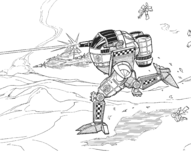Hornet

| |
| Hornet | |
|---|---|
| Production information | |
| Manufacturer | Kallon Industries[1] |
| Production Year | 2760[2] |
| Model | HNT-171[1] |
| Class | Light[1][[Category:Light[1] BattleMechs]] |
| Cost | 1,441,600 C-bills |
| Technical specifications | |
| Mass | 20[1] tons[[Category:20[1] ton BattleMechs]] |
| Chassis | Corean Model KL-77 Endo Steel[1] |
| Armor | StarGuard CIV Ferro-Fibrous[1] |
| Engine | Hermes 100[1] |
| Communications System | Tri-Word Duplex 4880[1] |
| Targeting Tracking System | Dalban HiRez II[1] |
| Heat Sinks | 10[1] |
| Speed | 86[1] km/h |
| Jump Jets | Pitban LFT-50[1] |
| Armament |
|
| BV (1.0) | 491 |
| BV (2.0) | 535[1][3] |
Contents
Description
The Hornet debuted in 2760 as an urban recon 'Mech, but lack of interest forced the design to be shelved two years later. In 2990, Kallon Industries rediscovered the blueprints and resumed production. The upgraded HNT-171 started production in 3051. The production line was destroyed by the Capellans in 3069. The 'Mech is designed around the concept of being able to swiftly move through an urban environment with relatively heavy armor. Overall, because of its eclectic mix of weapons and relatively slow speed, the Hornet is only somewhat effective when inside of a city. When caught outside an urban environment the 'Mech is hard pressed to defend itself.[1][2]
Weapons and Equipment
Kallon had a hard time selling the Hornet to the Armed Forces of the Federated Suns, so most of these 'Mechs initially went to the mercenary market. A major user of the initial runs was Wolf's Dragoons, who demonstrated its effectiveness on Misery. This caused the Federated Suns to take renewed interest in this 'Mech.[2]
Since then, the Hornet has been deployed by March Militias as a replacement for Wasps and Stingers, as well as by the Ceti Hussars and Deneb Light Cavalry. It is also still popular among mercenaries.[1][2]
Armament
The Hornet carries as its primary long-range weapon a Holly LRM-5 launcher. This allows the Hornet to strike at an enemy at a distance of over six hundred meters. In an urban environment the LRM launcher becomes more of a liability than an asset. As a secondary weapon the Hornet carries a Martell Medium Laser, and finally the 'Mech is armed with a MainFire Point Defense Anti-Missile System to defend against missile attacks.[1]
Variants
- HNT-151
- The version of the Hornet that debuted in 2990, the 151, has standard armor and a standard internal structure. It also lacks the advanced Anti-Missile System, CASE, and a ton of LRM ammunition, though the jumping capacity is one hundred fifty meters and the weapons also include a small laser.[2] BV (1.0) = 429, BV (2.0) = 488[4]
- HNT-161
- Wolf's Dragoons fields this variant, which eschews the anti-missile system in favor of a full one-hundred fifty meters of jumping and the Small Laser. BV (1.0) = ??, BV (2.0) = 511[6]
- HNT-181
- Based on the 161, and producted by Coalition Armory Inc. this Hornet variant was produced by using a 100XL engine with ten Compact Heat Sinks. It is protected by three and a half tons of Ferro-Fibrous Armor, and uses an Endo Steel chassis. It carries a Small Re-Engineered Laser, Small Laser, and an MML-5 with two tons of ammunition in a CASE protected bay. It is most frequently seen in the service of AFFS and Filtvelt Coalition militias.[7] BV (2.0) = 394[7]
- HNT-182
- A field refit of the 181 Hornet, this model replaces the small lasers with standard Medium Lasers. BV (2.0) = 505[8]
Design Quirks
The HNT-181 Hornet variant is subject the the following Design Quirks:[7]
BattleMech Gallery
The HNT-171 Hornet from the original TRO:3050
Trivia
In The Spider and the Wolf, a Hornet appears drawn like the Legios fighter/Alpha Veritech from the anime Genesis Climber Mospeada, also used as part of the Robotech series; which would have made this mech one of the Unseen had it not later been identified as an error and declared non-canonical. All subsequent depictions of the Hornet have had it's present shape.
References
- ↑ 1.00 1.01 1.02 1.03 1.04 1.05 1.06 1.07 1.08 1.09 1.10 1.11 1.12 1.13 1.14 1.15 Technical Readout: 3050 Upgrade, pp. 10-11, "HNT-171 Hornet 'Mech Profile"
- ↑ 2.0 2.1 2.2 2.3 2.4 Technical Readout: 3039, pp. 244-245, "Hornet 'Mech Profile"
- ↑ Record Sheets: 3050 Upgrades Unabridged (Inner Sphere), p. 11
- ↑ Record Sheets: 3039, p. 60
- ↑ Record Sheets: 3039, p. 61
- ↑ Record Sheets: 3050 Upgrades Unabridged (Inner Sphere), p. 10
- ↑ 7.0 7.1 7.2 Experimental Technical Readout: Republic, Volume 2, p. 6
- ↑ Experimental Technical Readout: Republic, Volume 2, p. 24






